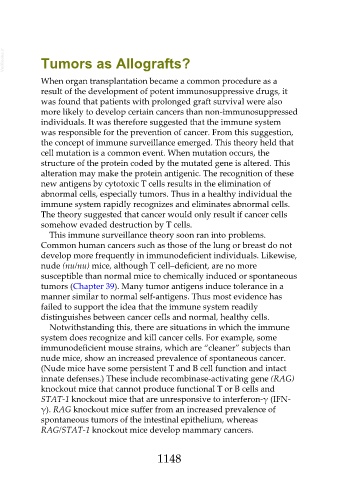Page 1148 - Veterinary Immunology, 10th Edition
P. 1148
VetBooks.ir Tumors as Allografts?
When organ transplantation became a common procedure as a
result of the development of potent immunosuppressive drugs, it
was found that patients with prolonged graft survival were also
more likely to develop certain cancers than non-immunosuppressed
individuals. It was therefore suggested that the immune system
was responsible for the prevention of cancer. From this suggestion,
the concept of immune surveillance emerged. This theory held that
cell mutation is a common event. When mutation occurs, the
structure of the protein coded by the mutated gene is altered. This
alteration may make the protein antigenic. The recognition of these
new antigens by cytotoxic T cells results in the elimination of
abnormal cells, especially tumors. Thus in a healthy individual the
immune system rapidly recognizes and eliminates abnormal cells.
The theory suggested that cancer would only result if cancer cells
somehow evaded destruction by T cells.
This immune surveillance theory soon ran into problems.
Common human cancers such as those of the lung or breast do not
develop more frequently in immunodeficient individuals. Likewise,
nude (nu/nu) mice, although T cell–deficient, are no more
susceptible than normal mice to chemically induced or spontaneous
tumors (Chapter 39). Many tumor antigens induce tolerance in a
manner similar to normal self-antigens. Thus most evidence has
failed to support the idea that the immune system readily
distinguishes between cancer cells and normal, healthy cells.
Notwithstanding this, there are situations in which the immune
system does recognize and kill cancer cells. For example, some
immunodeficient mouse strains, which are “cleaner” subjects than
nude mice, show an increased prevalence of spontaneous cancer.
(Nude mice have some persistent T and B cell function and intact
innate defenses.) These include recombinase-activating gene (RAG)
knockout mice that cannot produce functional T or B cells and
STAT-1 knockout mice that are unresponsive to interferon-γ (IFN-
γ). RAG knockout mice suffer from an increased prevalence of
spontaneous tumors of the intestinal epithelium, whereas
RAG/STAT-1 knockout mice develop mammary cancers.
1148

